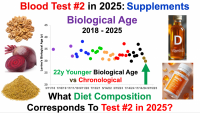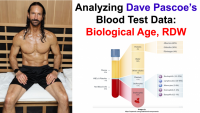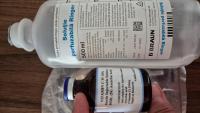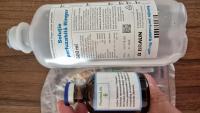ImmInst Active Topics
 Last Updated:
03 May 2025 - 12:16 AM
Last Updated:
03 May 2025 - 12:16 AM
Hi, I am Kat 29 April 2025 - 10:52 AM
Always running multiple micro-experiments of various timescales on personal longevity: testing interventions, tracking results, refining strategies.
Would love to share real-world data with like-minded people focused on testing and refining and optimizing. Been a performance hacker for >15 years now, a longevity hacker for the last 5+.
I’ve been a performance hacker for over 15 years and a longevity hacker for the last 5+. Big fan of informed interventions — measure first, then act.
Here to share what I learn along the way and to learn from everyone else.
I am founder of the Longevity Vault, here we focus on:
![]() Accelerated Aging Detection — spotting early signs that your biology is aging faster than your age
Accelerated Aging Detection — spotting early signs that your biology is aging faster than your age
![]() Performance Longevity — building strength, cognitive resilience, and durability that lasts
Performance Longevity — building strength, cognitive resilience, and durability that lasts
![]() Personalized Roadmaps — turning biomarker data and environmental risks into a actionable, evolving longevity strategy
Personalized Roadmaps — turning biomarker data and environmental risks into a actionable, evolving longevity strategy
How He Reversed His Age by 21 Years (ft. Michael Lustgarten) 28 April 2025 - 10:33 PM
I was diagnosed with Right Ventricle Hypertrophy 28 April 2025 - 02:21 PM
I was diagnosed with RVH (Right Ventricle Hypertrophy), but the tests don´ t mention
pulmonary hypertension as the cause of it. Are there any supplements that can reverse
it or, at least, stop the growth of ventricle? Some say that L-Carnitine can do it, but at what dose? Does exist a liposomal version of L-Carnitine or a reputable brand?
Experiences with SGLT2 inhibitors? 25 April 2025 - 01:13 PM
I've been hearing a good bit about the potential benefits of SGLT2 inhibitors on healthspan and lifespan. I'm curious to see if anyone here has taken them and has experiences or side effects to report.
On a related note, does anyone know of a good source to purchase them without a prescription?
22y Younger Biological Age: Supplements, Diet (Blood Test #2 in 2025) 23 April 2025 - 12:45 PM
Dave Pascoe Presents His Blood Test Results: Biological Age, RDW (Part I) 20 April 2025 - 11:06 AM
VITAMIN C IV Intravenous 19 April 2025 - 02:20 PM
Megadosing Vitamin C: A Case for Simplicity Over Micromanagement 18 April 2025 - 09:45 AM
Megadosing Vitamin C: A Case for Simplicity Over Micromanagement
By
ChatGPT
Vitamin C megadosing has long had its proponents—those who swear by high doses to fend off illness, boost immune resilience, or simply maintain vitality. Stories abound of people taking anywhere from a few grams to 100 grams per day during acute illness, with claims of fewer colds, faster recovery, and long-term health benefits.
But with high-dose vitamin C comes the inevitable conversation about regulation—how much is too much, and how do you know? Some suggest watching your urine color: if it turns bright yellow or fluorescent, your body is likely excreting the excess. Others recommend dialing back your dose if you notice diarrhea, burning sensations while urinating, or general digestive upset.
This introduces a kind of micromanagement that, for many, defeats the purpose of a simple daily health practice. Having to observe your urine, interpret the results, and adjust accordingly adds an unnecessary layer of complication to what should be an easy, straightforward routine.
The reality is: vitamin C is water-soluble. The body uses what it needs and discards the rest. Unless you’re taking truly massive doses—think 20+ grams daily over long periods—the risk of harm is minimal for most healthy individuals. And if your body tolerates your chosen dose (say, 5 grams a day) without unpleasant side effects, there’s little need to monitor things obsessively.
Moreover, urine color isn’t a reliable indicator of vitamin C levels. Hydration, B vitamins, medications, and even certain foods can alter its appearance. Relying on this as a feedback mechanism for dosing is not only imprecise—it can be misleading.
Of course, those with kidney conditions, a history of oxalate stones, or other specific health concerns may need to be more cautious. But for the average person, a steady, well-tolerated dose of vitamin C—taken daily without obsessing over it—is a reasonable, low-maintenance way to support general health.
In the end, the goal of supplementation should be to enhance life, not complicate it. If your routine requires constant surveillance and adjustment, it stops being a health aid and starts becoming a chore. For most people, a consistent dose that feels right, causes no discomfort, and fits seamlessly into their day is the most practical—and sustainable—approach.
Microdosing Testosterone Boosters: Does It Work? 18 April 2025 - 08:41 AM
Best Testosterone Booster Supplements - Whether you are hitting the gymnasium, grinding through paintings, or just looking to sense like your antique self again—getting your T-levels in take a look at could make a big distinction.
Official Website:
https://finance.yahoo.com/news/best-testosterone-supplement-men-over-075400959.html
https://sg.finance.yahoo.com/news/best-testosterone-booster-supplements-muscle-155300606.html
Facebook:
https://www.facebook.com/MaleTestosteroneBoosters/
https://www.facebook.com/groups/besttestosteroneboosterforgainingmuscle
https://www.facebook.com/BestTestosteroneBoosterForED/
https://www.facebook.com/BestTestosteroneBoosterformen
https://www.facebook.com/BestTestosteroneBoostersSupplementsForMen/
https://www.facebook.com/groups/besttestosteroneboostersformenover40
https://www.facebook.com/groups/besttestosteroneboostersoverthecounter
Read More Here:
https://best-testosterone-booster-supplement65.mywebselfsite.net/
https://testosterone-booster-for-men.mywebselfsite.net/
https://best-testosterone-booster-for-erectile-dysfunction.mywebselfsite.net/
https://best-testosterone-boosters.mywebselfsite.net/
https://best-testosterone-boosters-for-men-over-40.mywebselfsite.net/
https://best-testosterone-boosters-over-the-counter.mywebselfsite.net/
https://best-testosterone-boosters-for-men-over-5096.mywebselfsite.net/
https://best-testosterone-booster-to-gain-muscle.mywebselfsite.net/
https://best-testosterone-booster-to-build-muscle.mywebselfsite.net/
https://best-testosterone-booster-supplement-1.jimdosite.com/
https://best-testosterone-booster-for-erectile-dysfunction.jimdosite.com/
https://testosterone-booster-for-men.jimdosite.com/
https://best-testosterone-boosters.jimdosite.com/
https://best-testosterone-boosters-for-men-over-40.jimdosite.com/
https://best-testosterone-boosters-over-the-counter.jimdosite.com/
https://best-testosterone-boosters-for-men-over-50-3.jimdosite.com/
https://best-testosterone-booster-to-build-muscle.jimdosite.com/
https://besttestosteroneboostersuppl58.godaddysites.com/
https://testosteroneboosterformen0.godaddysites.com/
https://besttestosteroneboosterforerec.godaddysites.com/
https://besttestosteroneboosters.godaddysites.com/
https://besttestosteroneboostersoverme.godaddysites.com/
https://besttestosteroneboostersoverth.godaddysites.com/
https://besttestosteroneboostersforme0.godaddysites.com/
https://besttestosteroneboostertogainm.godaddysites.com/
https://besttestosteroneboostertobuild.godaddysites.com/
https://best-testosterone-booster-supplements.mystrikingly.com/
https://testosterone-booster-for-men.mystrikingly.com/
https://best-testosterone-booster-for-erectile-dysfunction.mystrikingly/
https://best-testosterone-boosters-for-men-over50.mystrikingly.com/
https://best-testosterone-booster-to-gain-muscle.mystrikingly.com/
https://best-testosterone-booster-to-build-muscle.mystrikingly.com/
https://best-testosterone-booster-supp-ddf972.webflow.io/
https://testosterone-booster-for-men.webflow.io/
https://testosterone-booster-pills-for-men.blogspot.com/2025/04/testosterone-booster-for-men.html
https://best-testosterone-boosters-2025.blogspot.com/2025/03/best-testosterone-boosters.html
https://best-testosterone-booster-uses.blogspot.com/2025/03/best-testosterone-booster-to-gain.html
https://best-testosterone-booster-2025.blogspot.com/2025/03/best-testosterone-booster-to-build.html
https://colab.research.google.com/drive/1hAJlEsW9BEPsKsq6dHK0OhjLZgsKzA8C
https://colab.research.google.com/drive/1FJkWCdgGQoDyeb1FFImi0-3c1Y4osTyY
https://colab.research.google.com/drive/1ZSFvJ05NrL1xovgrgipJsTZDCDpM8VaZ
https://colab.research.google.com/drive/1nhzGMb77QCskNGKlGF42ulu3m1LGY6bU
https://colab.research.google.com/drive/1Q7mVwAfPUhMzRy4j_LukQVqbEFt4dU0i
https://colab.research.google.com/drive/1H5B5URc7xgZEsP1yu2QteFHN33gcTx-7
https://colab.research.google.com/drive/12I8MfJel_uZM_gm3vWIJ_bLmn2A2pT9h
https://colab.research.google.com/drive/1C2fkhGDhSZ3CjGSCgSsOroz9chJlSJRA
https://colab.research.google.com/drive/1FEZ9JYxlE7YBogiA9D92WIjbj0DlsT0l
FDA Fast Tracks Self Amplifying mRNA 17 April 2025 - 10:01 PM
"SAN DIEGO--(BUSINESS WIRE)--Apr. 10, 2025-- Arcturus Therapeutics Holdings Inc. (the “Company”, “Arcturus”, Nasdaq: ARCT), a commercial messenger RNA medicine company focused on the development of infectious disease vaccines and opportunities within liver and respiratory rare diseases, today announced that the U.S. Food and Drug Administration (FDA) has granted Fast Track Designation for the self-amplifying mRNA (sa-mRNA) vaccine candidate, ARCT-2304, designed for active immunization to protect against disease caused by influenza A H5N1 subtype contained in the vaccine. This designation recognizes the potential of ARCT-2304 as an innovative approach to address unmet medical needs for the prevention of disease caused by pandemic influenza A virus H5N1, a significant global health risk. The Phase 1 clinical study initiated in November 2024.
Fast Track Designation from the FDA is granted to vaccines intended to prevent serious conditions caused by infectious disease. The designation is designed to expedite the development and review process, providing several benefits, including enhanced communication with the FDA and eligibility for priority review, and the possibility of a rolling review.
“We are pleased to receive Fast Track Designation from the FDA for ARCT-2304,” said Joseph Payne, President and CEO of Arcturus Therapeutics. “We remain steadfast in our commitment to the U.S. government to develop safe and effective STARR® next-generation mRNA vaccines to protect U.S. citizens from future pandemic threats. This designation from the FDA is an important step forward in our mission to provide protective solutions for global health crises.”
This project has been supported in whole with federal funds from the Department of Health and Human Services; Administration for Strategic Preparedness and Response; Biomedical Advanced Research and Development Authority (BARDA), under contract number 75A50122C0007.
"
It's unclear to me if a person getting this can then shed the mRNA to another host.
According to AI:
Self-amplifying mRNA (saRNA) vaccines do not cause shedding, meaning they do not release the mRNA or any infectious virus particles into the environment that could potentially infect others. The saRNA mechanism involves a viral replicase encoded within the saRNA itself, which amplifies the RNA within the vaccinated individual's cells. This amplification leads to increased antigen production, but the saRNA does not replicate outside of the cells.
Here's why saRNA vaccines don't shed:
No Viral Replication Outside Cells:
The saRNA itself is not infectious and does not replicate outside of the cells in which it is delivered.
No Viral Components Released:
The saRNA contains a viral replicase, but this is not a viral particle and is not released into the environment.
Temporary Expression:
The encoded protein (antigen) is expressed by the cells, stimulating the immune system, but the cells eventually stop producing the protein, and the saRNA degrades.
In essence, the saRNA vaccine works by tricking the body's cells into temporarily producing the protein that triggers an immune response, without causing any shedding or infection.
2 user(s) are viewing this feed (in the past 15 minutes)
0 members, 2 guests, 0 anonymous users

































